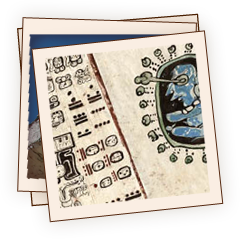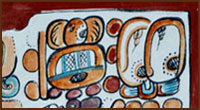The Maya developed a writing system with hieroglyphs, a combination of whole-word symbols and syllables. Their script contains approximately 800 signs or glyphs. In order to decipher and understand the meanings of the hieroglyphs, the signs need to be matched to the language encoded in the script. The “voice” of Maya hieroglyphs is rooted in three spoken Mayan languages: Yucatec, Ch’olan, and Ch’orti’. Since the 1950s, scholars from all over the world have been able to decipher and read a large portion of the Maya hieroglyphs. These hieroglyphs are found carved in stone at archaeological sites, painted on ceramic vases, and painted on paper in accordion-shaped books called codices. Use this interactive tool to “read” the glyphs from stone carvings related to the Maya calendar.
Reading the Calendar Glyphs
See explanation of each glyph below diagram as you click.
This feature best viewed on desktop.
- 13 baktun
- 0 katun
- 0 tun
- 0 winal
- 0 kin
- 4 Ajaw
- 8 Kumk’u
- Hearth glyph
- Three stones glyph
- Paddler Gods glyph
- Tuun stone
- Unknown glyph
- Nah Ho’ Chan glyph
- Jaguar stone glyph
- God glyph
- Ihk’ Naah Chak glyph
- Lakam Kaaj glyph
- Shark stone glyph
- God glyph
- Itzamnaah Yahx Kokaaj Muut glyph
- Water stone glyph
- Sky edge glyph
- First Three Stone Place glyph
- 13 baktun glyph
- Supreme God glyph
- Wak Chan Ajaw glyph
- Complete
Our spoken language and our glyphs are our identity. More and more, Maya people are interested in understanding our history that is recorded in the glyphs. Understanding implies engagement, respect, and appreciation of the legacy of our ancestors.
Stela C of Quiriguá
Standing more than 12 feet (4 meters) high, Stela C in the ancient Maya city of Quiriguá in Guatemala is an impressive monument. This “stone tree” preserves one of the most complete narratives of the creation story of the Maya.
Maya Glyphs are read in paired columns, from left to right and top to bottom. Epigraphers or experts who decipher the meaning of Maya glyphs first transcribe the Maya text, writing the sounds as they would be heard by a Maya speaker. Then, they translate the text to English and other languages.
Instructions for Interactive: Click on the individual glyphs in the Stela C representation to learn more. To read the complete story written on the stela, click on the link at the bottom of the interactive.
* Hieroglyphs were deciphered by Dr. Erik Velásquez of the Universidad Nacional Autónoma de México.


